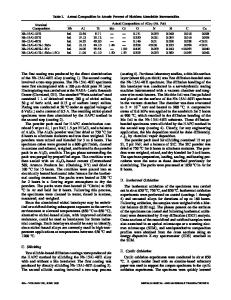Effects of Pt incorporation on the isothermal oxidation behavior of chemical vapor deposition aluminide coatings
- PDF / 7,072,873 Bytes
- 15 Pages / 612 x 792 pts (letter) Page_size
- 0 Downloads / 291 Views
NTRODUCTION
CURRENTLY, state-of-the-art thermal-barrier coating (TBC) systems are comprised of two layers: (1) a straintolerant ceramic top coat (Y2O3-stabilized ZrO2 (YSZ)) and (2) a metallic bond coat, which typically consists of a plasmasprayed NiCoCrAlY or a diffusion aluminide. The ceramic top coat provides thermal insulation, while the metallic bond coat provides oxidation protection to the superalloy substrate by forming a protective Al2O3 scale along the YSZ-bond coat interface. Failure of electron beam-physical vapor deposition (EB-PVD) TBCs is typically associated with fracture and delamination of the brittle Al2O3 scale along the scale–bond coat interface, which results in spallation of the ceramic top coat[1–4] and a concomitant loss of thermal protection. From this perspective, development of bond coats with significantly improved Al2O3 scale adherence is a critical step in improving the performance of state-of-the-art TBC systems. A common method of improving the oxidation resistance of aluminide coatings is to incorporate Pt,[5,6] although the mechanism by which Pt exerts its beneficial effects is not well understood. Most previous work in this area has focused Y. ZHANG, Research Professor, formerly with the University of Tennessee, is with the Center for Manufacturing Research, Tennessee Technological University, Cookeville, TN 38505-0001. J.A. HAYNES, I.G. WRIGHT, and B.A. PINT, Research Staff Members, and K.M. COOLEY, Technician, are with the Oak Ridge National Laboratory, Oak Ridge, TN 37831-6063. W.Y. LEE, Associate Professor and Department Director, is with the Department of Chemical, Biochemical and Materials Engineering, Stevens Institute of Technology, Hoboken, NJ. P.K. LIAW, Professor, is with the Department of Materials Science and Engineering, University of Tennessee, Knoxville, TN 37996. Manuscript submitted July 5, 2000. METALLURGICAL AND MATERIALS TRANSACTIONS A
on platinum aluminide coatings fabricated by pack cementation, which results in a surface layer of either PtAl2 or (PtAl2 ⫹ (Ni,Pt)Al).[7,8,9] More recently, a low-activity platinum aluminide coating, that exhibits a surface layer of single-phase (Ni,Pt)Al instead of PtAl2 or (PtAl2 ⫹ (Ni,Pt)Al) has been developed via low-Al-activity CVD processing.[10,11] This single-phase (Ni,Pt)Al coating has been incorporated as a bond coat for commercial EB-PVD TBC systems. There has been limited evaluation of low-activity platinum aluminide bond coatings, although the available results indicate improvements in cyclic oxidation behavior, hot corrosion resistance, thermal stability, and ductility, as compared to platinum aluminide coatings fabricated by pack cementation.[11,12,13] In general, it appears that the positive influence of Pt primarily involves an improvement in Al2O3 scale adherence. A variety of mechanisms to explain the beneficial effects of Pt have been proposed, including (1) reductions in oxide growth stresses,[14] (2) enhanced diffusion of Al in the coating,[15] (3) mechanical keying by alloy protrusions into the scale,[16
Data Loading...











